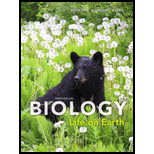
Concept explainers
The science of naming and classifying organisms is called __________. The related science of reconstructing and depicting evolutionary history is called __________. A group consisting of all organisms descended from a particular common ancestor is a(n) ____________.
To review:
The given blank space in the statement, “the science of naming and classifying organisms is called ______. The related science of reconstructing and depicting evolutionary history is called _______. A group consisting of all organisms descended from a particular common ancestor is a _______.”
Introduction:
Classification of organisms is important in their respective hierarchical group. It helps in the prediction of earlier life forms on the basis of their character similarities. Also, classification set a standard format to study the organism in a new and better way. The systematic study of an organism based on certain perspectives help to establish a relationship between different kinds of species on the basis of their evolutionary characters.
Explanation of Solution
Taxonomy: It is a type of methodology used to classify the biologically active organism into their respective hierarchy. They are arranged and placed in a highly organized manner depending on the extent of shared characters. A taxon is described as one unit comprising of a specific type/group of organisms. This type of classification was first developed by Carolus Linnaeus. The classification consists of eight ranks: domain, kingdom, phylum, class, order, family, genus, and species.
Systematics: It is a type of study explaining the existence of various life forms present in their evolutionary aspects. This helps in establishing a relationship between the present organisms their ancestral species. The study is visualized and analyzed as an evolutionary tree. It is also known as phylogenetic trees. The main component of this study involves branching order and branching length. The classification and identification of species are done on the basis of the evolutionary changes. Thus, it is a method to study the extent of change in either the morphological or physiological trait in an organism via evolution.
Clades: It is a type of family tree of an organism, which joins its branches from a common ancestor to all organisms diversified from the ancestor. It is helpful in predicting the evolutionary history of an organism. The determining feature of this tree is based on the homologous characters of the organism. This establishes a relationship between the descendants of the organism to its recent form by analyzing them on various aspects.
Thus, the science of naming and classifying organisms is called taxonomy. The related science of reconstructing and depicting evolutionary history is called systematics. A group consisting of all organisms descended from a particular common ancestor is a clade.
Want to see more full solutions like this?
Chapter 18 Solutions
Biology: Life on Earth
- Describe three cranial and postcranial features of Neanderthals skeletons that are likely adaptation to the cold climates of Upper Pleistocene Europe and explain how they are adaptations to a cold climate.arrow_forwardBiology Questionarrow_forward✓ Details Draw a protein that is embedded in a membrane (a transmembrane protein), label the lipid bilayer and the protein. Identify the areas of the lipid bilayer that are hydrophobic and hydrophilic. Draw a membrane with two transporters: a proton pump transporter that uses ATP to generate a proton gradient, and a second transporter that moves glucose by secondary active transport (cartoon-like is ok). It will be important to show protons moving in the correct direction, and that the transporter that is powered by secondary active transport is logically related to the proton pump.arrow_forward
- drawing chemical structure of ATP. please draw in and label whats asked. Thank you.arrow_forwardOutline the negative feedback loop that allows us to maintain a healthy water concentration in our blood. You may use diagram if you wisharrow_forwardGive examples of fat soluble and non-fat soluble hormonesarrow_forward
- Just click view full document and register so you can see the whole document. how do i access this. following from the previous question; https://www.bartleby.com/questions-and-answers/hi-hi-with-this-unit-assessment-psy4406-tp4-report-assessment-material-case-stydu-ms-alecia-moore.-o/5e09906a-5101-4297-a8f7-49449b0bb5a7. on Google this image comes up and i have signed/ payed for the service and unable to access the full document. are you able to copy and past to this response. please see the screenshot from google page. unfortunality its not allowing me attch the image can you please show me the mathmetic calculation/ workout for the reult sectionarrow_forwardIn tabular form, differentiate between reversible and irreversible cell injury.arrow_forwardhelparrow_forward
- Can you please help me answer these questions?arrow_forwardSkryf n kortkuns van die Egyptians pyramids vertel ñ story. Maximum 500 woordearrow_forward1.)What cross will result in half homozygous dominant offspring and half heterozygous offspring? 2.) What cross will result in all heterozygous offspring?arrow_forward

 Concepts of BiologyBiologyISBN:9781938168116Author:Samantha Fowler, Rebecca Roush, James WisePublisher:OpenStax College
Concepts of BiologyBiologyISBN:9781938168116Author:Samantha Fowler, Rebecca Roush, James WisePublisher:OpenStax College Biology: The Dynamic Science (MindTap Course List)BiologyISBN:9781305389892Author:Peter J. Russell, Paul E. Hertz, Beverly McMillanPublisher:Cengage Learning
Biology: The Dynamic Science (MindTap Course List)BiologyISBN:9781305389892Author:Peter J. Russell, Paul E. Hertz, Beverly McMillanPublisher:Cengage Learning Biology Today and Tomorrow without Physiology (Mi...BiologyISBN:9781305117396Author:Cecie Starr, Christine Evers, Lisa StarrPublisher:Cengage LearningEssentials Health Info Management Principles/Prac...Health & NutritionISBN:9780357191651Author:BowiePublisher:Cengage
Biology Today and Tomorrow without Physiology (Mi...BiologyISBN:9781305117396Author:Cecie Starr, Christine Evers, Lisa StarrPublisher:Cengage LearningEssentials Health Info Management Principles/Prac...Health & NutritionISBN:9780357191651Author:BowiePublisher:Cengage Human Biology (MindTap Course List)BiologyISBN:9781305112100Author:Cecie Starr, Beverly McMillanPublisher:Cengage Learning
Human Biology (MindTap Course List)BiologyISBN:9781305112100Author:Cecie Starr, Beverly McMillanPublisher:Cengage Learning





